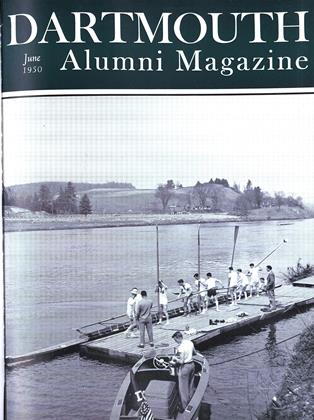by CarlBridenbaugh '25. New York UniversityPress, pp. 215, $4.25.
This is a book about the Colonial Craftsman, alive and fighting, and his contribution to Colonial America. Mr. Bridenbaugh states that for many years he had wanted to read a work about the colonial craftsman. Since no such treatment existed he proceeded to write one. I am most grateful to Mr. Bridenbaugh for writing this book because I, too, have wanted to find a book like this one.
In the author's own words, "I propose to discuss the artisan or craftsman rather than the things he produced or the process he used. It is the fundamental importance of the contribution this man and his fellows made to colonial society rather than the quaintness of a Betty lamp or the exclusiveness attaching to the possession of a unique Revere creamer or a block-front desk by Goddard. We have too long been blinded by the crowed displays of antiques in the Fifty-Seventh Street shops and "Ye Olde" emporiums of New England and Pennsylvania. It is the actual people, real living human beings, who made the artifacts needed both for the existence and embellishment of eighteenth-century living that I wish to pass before you." The result is a lively and scholarly treatise.
The craftsman's lot in life is near my own heart and the esteem in which he is held by his fellow men is of great interest, also. I am grateful to Mr. Bridenbaugh for recording the following statement by the Reverend Mr. Foxcraft from the funeral sermon for John Coney, famous Boston silversmith who died in 1712, "He was a rare Example of Industry, a great Redeemer of his Time, taking care to spend not only his Days, but his Hours well, and giving Diligence in his Business; yet this (as he sometimes modestly professed) not from a selfish wordly principle, but from a sense of the Worth of Time and Conscience of Duty; to serve his Generation, and employ Talents. He was excellently talented for the Employment assigned and Took a peculiar Delight herein He managed his Affairs with Discretion He was a Humble Man."
The organization of the material presented in the book gives us a clue to the content: "The Craftsman of the Rural South," "The Village Craftsman of the Rural North," "The Urban Craftsman," "The Craftsman at Work," and "The Craftsman as a Citizen."
Do you know why the Colonial South imported most of her products from England while the North grew increasingly independent and developed craftsman equal to the best in Europe? Do you know the extent of the Yankee Craftsman's contribution to Democratic and Independent America? Did you know that in 1775 Colonial America produced one-seventh of the iron produced in the entire world? If so, do you realize the difficulties under which these achievements were made. And, above all, have you considered the type of independent American this development produced? If you are interested in this important era of development of our country, all means read The Colonial Craftsman. Don't miss this story of the development of the Penn- sylvania (commonly known as Kentucky) Rifle, the Connestoga Wagon, the competitive battle of neighboring artisans, the stern masters, and the "wenching, gambling, drinking" journeyman. The story of these men and their driving desire to get ahead in the world and rise of the Leather Apron Club to a position of respectable economic and social rank will give you a new faith in America.
Mr. Bridenbaugh gives us the following summary, "This, then, is the story of the craftsman who gave colonial society many things of use and beauty; it is the tale of men and boys who wrought with their hands and tools, as well as with their minds, in the building of an American society; it is the chronicle of our first manufacturers and of our first laboring men."
The Colonial Craftsman is handsomely illustrated with appropriate and excellent engravings from the French Encyclopedia of the same period.
TOM ALLEN '52, NO. 2 ON THE GREEN TENNIS TEAM, IN ACTION AGAINST YALE
 View Full Issue
View Full Issue
More From This Issue
-
 Article
ArticleTop Television Man
June 1950 By ROBERT R. RODGERS '42 -
 Class Notes
Class Notes1918
June 1950 By ERNEST H. EARLEY, DONALD L. BARR, RICHARD A. HOLTON -
 Class Notes
Class Notes1929
June 1950 By F. WILLIAM ANDRES, EDWIN C. CHINLUND, GEORGE B. REDDING -
 Class Notes
Class Notes1937
June 1950 By ROBERT C. BANKART, ARTHUR H. RUGGLES JR., ALAN W. BRYANT -
 Class Notes
Class Notes1923
June 1950 By TRUMAN T. METZEL, COLIN C. STEWART 3RD, LEON H. YOUNG JR. -
 Class Notes
Class Notes1916
June 1950 By CMDR. F. STIRLING WILSON, DANIEL S. DINSMOOR, WILLIAM H. MCKENZIE
Virgil Poling
Books
-
 Books
BooksFaculty Publications
June 1935 -
 Books
BooksBriefly Noted
JUNE 1969 By J. H. -
 Books
BooksOHIO AN ARCHITECTURAL PORTRAIT
October 1973 By JOHN HURD '21 -
 Books
BooksMAS ALLA DEL HORIZONTE
July 1951 By R. Alberto Casas -
 Books
BooksMARRIAGE.
April 1933 By Ralph P. Holben -
 Books
BooksPARKER ON THE IROQUOIS. IROQUOIS USES OF MAIZE AND OTHER FOOD PLANTS. THE CODE OF HANDSOME LAKE, THE SENECA PROPHET. THE CONSTITUTION OF THE FIVE NATIONS.
JULY 1969 By ROBERT A. McKENNAN '25




